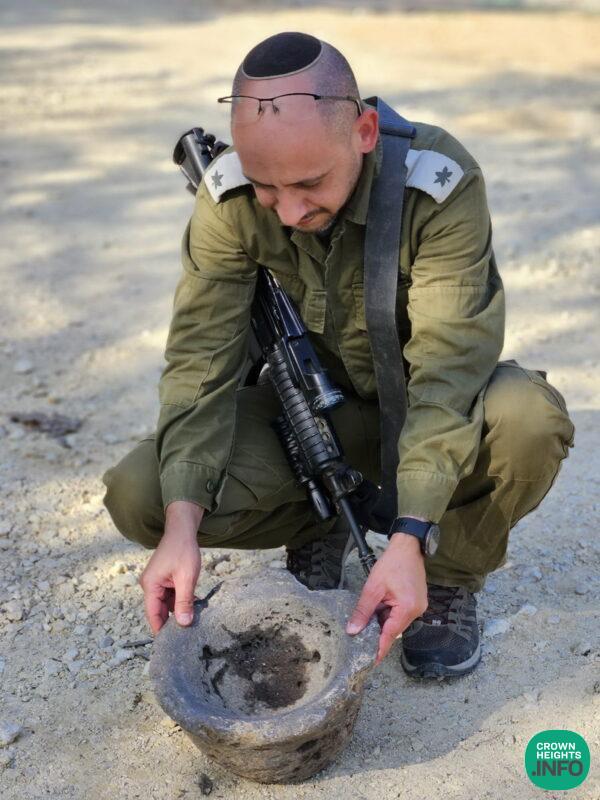
Ancient Grinding Mortar Vessel Discovered By Reserve Forces In Gaza Envelope
The reserve soldiers have done it again. After the Byzantine oil lamp that was found by the soldiers of the 404th Battalion of the 282nd Fire Brigade in the Gaza Envelope, now it is the 143rd Division’s turn, who discovered a complete large basalt grinding mortar vessel. The division’s soldiers, one of whom is an archaeologist at the Israel Antiquities Authority, handed the find to the National Treasures to be stored.
Lt. Col. (res.) Yair Amitzur, commander of the civilian frontline in the 143rd Division and Major (res.) Elyashiv Bohbut, who serves as the division’s second rabbi, discovered the basalt mortar, which weighs over 10 kg. “As part of our routine field patrols in the Gaza Envelope, our eye caught sight of a pile of soil on the side of the road, from which protruded a round basalt chunk,” said Elyashiv. “When we pulled it out, it turned out to be a rather large and heavy vessel. Yair, who is an archaeologist at the Israel Antiquities Authority, immediately recognized it as an ancient grinding mortar vessel.”
“Basalt is prevalent in the north of Israel and other fairly distant areas from here,” Yair explains. “It is, therefore, clear that the vessel was brought here from a distance. It was probably used in the past in the home of one of the local residents to grind grain and other produce using a stone pestle. We were excited to unexpectedly receive a greeting from the past and to deal with some good news for a change,” recalled Yair. “The mortar vessel reminds us that throughout the generations, the western Negev was an important area of settlement settled by different cultures and peoples. “Wars and battles were waged here in the past, but settlement was always renewed, and the area prospered again,” says Yair.
Mortars of this type were usually used for grinding and crushing agricultural produce such as grains, lentils, etc. The grinding process turned the grain into flour, necessary for preparing bread and other dishes. The mortar bowls were common in homes, while larger millstones were used in industrial areas to grind large quantities of flour.
Elyashiv and Yair handed the tool to the National Treasures of the Israel Antiquities Authority to be properly preserved. “We are doing important work here in the Gaza Envelope, but I’m looking forward to getting back to working full-time in archaeology,” Yair said with a smile.
Sarah Tal, Israel Antiquities Authority archaeologist in the Western Negev Region, collected the find in order to transfer it to the National Treasures of the Israel Antiquities Authority, and gave the findrs a certificate of good citizenship. “The grinding mortar is extremely well preserved. Such vessels were used in many periods from biblical times to the Mamluk period.”
“The war presents us with unusual situations on the archaeological front as well,” says Eli Escusido, Director of the Israel Antiquities Authority. “The Land of Israel – and especially the Gaza Envelope – is saturated with history and ancient artifacts, and the Israel Antiquities Authority cooperates with the Israel Defense Forces in order to preserve them, even in a state of war. In the event of discovering an ancient find, it is important to leave it in place and call the Israel Antiquities Authority inspectors to the site in order to extract as much information as possible about the find and its ancient context.”
Photos: Israel Antiquities Authority
















